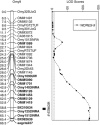A major effect quantitative trait locus for whirling disease resistance identified in rainbow trout (Oncorhynchus mykiss)
- PMID: 21048672
- PMCID: PMC3186244
- DOI: 10.1038/hdy.2010.137
A major effect quantitative trait locus for whirling disease resistance identified in rainbow trout (Oncorhynchus mykiss)
Abstract
Whirling disease, caused by the pathogen Myxobolus cerebralis, leads to skeletal deformation, neurological impairment and under certain conditions, mortality of juvenile salmonid fishes. The disease has impacted the propagation and survival of many salmonid species over six continents, with particularly negative consequences for rainbow trout. To assess the genetic basis of whirling disease resistance in rainbow trout, genome-wide mapping was initiated using a large outbred F(2) rainbow trout family (n=480) and results were confirmed in three additional outbred F(2) families (n=96 per family). A single quantitative trait locus (QTL) region on chromosome Omy9 was identified in the large mapping family and confirmed in all additional families. This region explains 50-86% of the phenotypic variance across families. Therefore, these data establish that a single QTL region is capable of explaining a large percentage of the phenotypic variance contributing to whirling disease resistance. This is the first genetic region discovered that contributes directly to the whirling disease phenotype and the finding moves the field closer to a mechanistic understanding of resistance to this important disease of salmonid fish.
Figures


References
-
- Addinsoft 2009XLStat version 2009Available at: : http://www.xlstat.com . Addinsoft Inc.: Paris, France
-
- Agresti JJ, Seki S, Cnaani A, Poompuang S, Hallerman EM, Umiel N, et al. Breeding new strains of tilapia: development of an artificial center of origin and linkage map based on AFLP and microsatellite loci. Aquaculture. 2000;185:43–56.
-
- Bartholomew JL, Reno PW.2002Review: the history and dissemination of whirling diseaseIn: Bartholomew JL, Wilson JC (eds). American Fisheries Society Symposium, Vol. 29: Whirling Disease: Reviews and Current Topics Bethesda, MD; 3–24.
Publication types
MeSH terms
LinkOut - more resources
Full Text Sources
Miscellaneous

